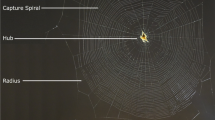Abstract
Orb-web spiders build vertically asymmetric webs, in which the lower part is larger than the upper part. One hypothesis explaining this asymmetry suggests that the spider’s mass imposes higher building costs in the upper part of the web, causing the spider to reduce this part of the web. We tested this hypothesis by assessing building costs of different parts of the web. We found that the specific time-cost of building (i.e. the time required to build a certain length of silk) differed between the two parts of the web and that the difference in time-costs influenced web asymmetry. Contrary to predictions, however, building costs were larger in the lower part of the web, suggesting that additional factors affect the spider’s decisions while building the web, which are likely to be prey-capture considerations.


Similar content being viewed by others
References
ap Rhisiart A, Vollrath F (1994) Design features of the orb web of the spider, Araneus diadematus. Behav Ecol 5:280–287
Benjamin SP, Zschokke S (2002) A computerized method to observe spider web building behavior in a semi-natural light environment. In: Toft S, Scharff N (eds) European arachnology 2000. Aarhus University Press, Aarhus, pp 117–122
Coslovsky M (2007) Asymmetry in spider webs: an adaptation to prey capture or to web building? Master Thesis, University of Basel
Foelix RF (1996) Biology of spiders, 2nd edn. Oxford University Press, New York
Heiling AM, Herberstein ME (1998) The web of Nuctenea sclopetaria (Araneae, Araneidae): relationship between body size and web design. J Arachnol 26:91–96
Heiling AM, Herberstein ME (1999) The role of experience in web-building spiders (Araneidae). Anim Cogn 2:171–177
Herberstein ME, Heiling AM (1999) Asymmetry in spider orb webs: a result of physical constraints? Anim Behav 58:1241–1246
Japyassú HF, Adés C (1998) From complete orb to semi-orb webs: developmental transitions in the web of Nephilengys cruentata (Araneae: Tetragnathidae). Behaviour 135:931–956
Masters WM, Moffat AJM (1983) A functional explanation of top–bottom asymmetry in vertical orbwebs. Anim Behav 31:1043–1046
Mayer G (1952) Untersuchungen über Herstellung und Struktur des Radnetzes von Aranea diadema und Zilla x-notata mit besonderer Berücksichtigung des Unterschiedes von Jugend- und Altersnetzen. Z Tierpsychol 9:337–362
Orians GH, Pearson NE (1979) On the theory of central place foraging. In: Horn DJ, Stairs GR, Mitchell RD (eds) Analysis of ecological systems. Ohio State University Press, Columbus, pp 155–177
Ramousse R (1973) Body, web-building and feeding characteristics of males of the spider Araneus diadematus (Araneae: Araneidae). Psyche 80:22–47
R Development Core Team (2006) R: a language and environment for statistical computing. R Foundation for Statistical Computing, Vienna, Austria. ISBN 3-900051-07-0. Available at http://www.R-project.org
Stephens DW, Krebs JR (1986) Foraging theory. Princeton University Press, Princeton, NJ
Vollrath F (1988) Untangling the spider’s web. Trends Ecol Evol 3:331–335
Vollrath F (1992) Analysis and interpretation of orb spider exploration and web-building behavior. Adv Study Behav 21:147–199
Vollrath F, Mohren W (1985) Spiral geometry in the garden spider’s orb web. Naturwissenschaften 72:666–667
Vollrath F, Downes M, Krackow S (1997) Design variability in web geometry of an orb-weaving spider. Physiol Behav 62:735–743
Wirth E, Barth FG (1992) Forces in the spider orb web. J Comp Physiol A 171:359–371
Witt PN, Reed CF (1965) Spider web-building. Measurement of web geometry identifies components in a complex invertebrate behavior pattern. Science 149:1190–1197
Witt PN, Rawlings JO, Reed CF (1972) Ontogeny of web-building behavior in two orb-weaving spiders. Am Zool 12:445–454
Zschokke S (2001) Optimal orb-web construction. Adv Ethol 36:294
Zschokke S, Herberstein ME (2005) Laboratory methods for maintaining and studying web-building spiders. J Arachnol 33:205–213
Zschokke S, Vollrath F (1995) Web construction patterns in a range of orb-weaving spiders (Araneae). Eur J Entomol 92:523–541
Zschokke S, Hénaut Y, Benjamin SP, Garcia-Ballinas JA (2006) Prey-capture strategies in sympatric web-building spiders. Can J Zool 84:964–973
Acknowledgments
We wish to thank Dr. Daniel Bloch for his computational and statistical advice; Dr. Peter Stoll for his statistical advice and for his remarks on the manuscript; and Prof. Yael Lubin for her helpful remarks. We are also grateful to three unknown referees for their useful remarks.
Author information
Authors and Affiliations
Corresponding author
Rights and permissions
About this article
Cite this article
Coslovsky, M., Zschokke, S. Asymmetry in Orb-Webs: An Adaptation to Web Building Costs?. J Insect Behav 22, 29–38 (2009). https://doi.org/10.1007/s10905-008-9151-2
Revised:
Accepted:
Published:
Issue Date:
DOI: https://doi.org/10.1007/s10905-008-9151-2




